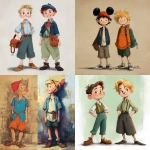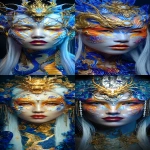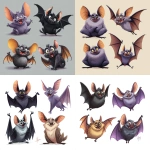Explore the Best AI Image Gallery

Beyond the Canvas: Wearable Techs Transformative Impact on Creativity
The realm of creativity is undergoing a profound transformation, fueled by the advent of wearable technology. These innovative devices, seamlessly integrating with our bodies and environments, are blurring the lines between the physical and digital, empowering artists, designers, and creators to explore new frontiers of expression and innovation.
A Canvas on Your Body: Wearable Tech in Creative Practice
Wearable tech is no longer confined to fitness trackers and smartwatches. Artists and designers are harnessing its potential to create interactive installations, immersive experiences, and captivating performances.
- Augmented Reality (AR) Wearables: AR glasses and headsets allow artists to overlay digital elements onto the real world, transforming mundane spaces into dynamic canvases for artistic expression. Imagine walking through a city where buildings morph into abstract sculptures or streets pulsate with interactive light installations.
- Haptic Feedback Devices: These wearables provide tactile sensations, enabling artists to create multi-sensory experiences that engage the sense of touch. A sculptor might feel the texture of a virtual clay model or a musician could experience the vibrations of a distant instrument.
- Biofeedback Wearables: By monitoring physiological data such as heart rate and brainwaves, artists can incorporate real-time biometric information into their creations. This allows for truly personalized and responsive artworks that react to the viewers emotional state or physical movements.
Empowering Collaboration: Wearable Tech Bridges Creative Gaps
Wearable tech fosters a new era of collaboration, breaking down geographical barriers and enabling creatives to work together seamlessly.
- Remote Collaboration Tools: Virtual reality (VR) headsets and collaborative platforms allow artists from different locations to share ideas, build projects together in real-time, and experience each others creative visions.
- Wearable Brainstorming: Imagine a team brainstorming session where participants wear haptic feedback devices that vibrate in sync, creating a shared sense of rhythm and inspiration. Wearables can facilitate more engaging and intuitive collaborative processes.
Navigating Ethical Terrain: Considerations for the Future
As wearable tech integrates deeper into creative practices, it raises important ethical considerations that require careful attention:
- Data Privacy and Security: Wearables collect vast amounts of personal data. Its crucial to ensure responsible data handling practices, transparent consent mechanisms, and robust security measures to protect user privacy.
- Accessibility and Inclusivity: Creative technologies should be accessible to all individuals, regardless of their abilities or socioeconomic background. Efforts are needed to design inclusive wearables that cater to diverse needs and promote equitable access to creative opportunities.
- Algorithmic Bias: AI algorithms used in wearable tech can perpetuate existing societal biases if not carefully developed and monitored. Its essential to address algorithmic bias to ensure fairness and inclusivity in creative applications.
Future Trends: The Evolution of Wearable Creativity
The future of wearable technology in the creative industry is brimming with exciting possibilities:
- Brain-Computer Interfaces (BCIs): BCIs could enable artists to control digital creations directly with their thoughts, unlocking a new level of intuitive and expressive creativity.
- Personalized Creative Experiences: Wearables will increasingly tailor creative experiences to individual preferences, allowing users to customize their artistic journeys and explore unique forms of self-expression.
- Extended Reality (XR) Fusion: The convergence of AR, VR, and mixed reality (MR) will create immersive creative environments where artists can collaborate, experiment, and push the boundaries of imagination.
As wearable technology continues to evolve, it has the power to reshape the very nature of creativity, democratize artistic tools, and empower individuals to express themselves in unprecedented ways. Embracing this transformative potential while navigating ethical considerations responsibly will be crucial for shaping a future where creativity knows no bounds.
](https://images.ai-img.art/thumbnails/150/2fbd98ecfc425cfc1597779121e1c0305437067779e9c471eb64ff9615d5be98.webp)

](https://images.ai-img.art/thumbnails/150/485c8b1c747827bdc9a962f8a1919b3c259b18dd263b260208a1eae19fb85e07.webp)
](https://images.ai-img.art/thumbnails/150/5197af8969d850e2a43e141d41e482ccbceedebceb2a4caf9f098f943f9d1b0f.webp)










](https://images.ai-img.art/thumbnails/150/8d1fe5a7a49cfc96747182431a853357913286d89258383caab2d3b4681afcb5.webp)



























](https://images.ai-img.art/thumbnails/150/269414b0e541026702e9e67c67602c96162f37ff460a388b3b36314c8fc936dd.webp)






](https://images.ai-img.art/thumbnails/150/3020b8c2b6d9be07e042357107af1de10deb274a41d2b0f332684ad4b532a702.webp)